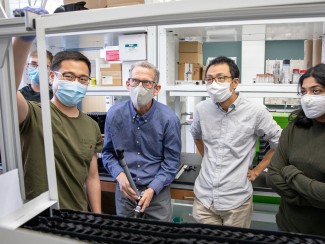UW–Madison spinoff Alithic prepares to enter the carbon capture market

Bu Wang didn’t set out to launch a carbon-capture company that would attract millions of dollars from major climate-focused investment firms.
In the pre-pandemic days of 2019, the associate professor of civil and environmental engineering was exploring the prospects of capturing carbon dioxide from coal-fired power plants—a line of research that he found, unfortunately, didn’t lead anywhere viable because of economic realities.
Amid that investigation, though, one of Wang’s postdoctoral researchers, Raghavendra Ragipani, made a fortuitous discovery. Ragipani, now an assistant professor of chemical engineering at the Indian Institute of Technology Kanpur, was testing how quickly carbon dioxide reacted with coal fly ash—the waste product from coal plants—under various conditions. He found the reaction occurred remarkably faster when the ash had a higher pH (was more basic, or alkaline), a result that hadn’t been documented in existing scientific literature.
“Initially we were very surprised,” says Wang, a Wisconsin Energy Institute affiliate whose work seeks to develop more sustainable materials. “We double-checked, triple-checked the results, but it turns out to be real.”
That bit of scientific happenstance set off a chain reaction that led Wang to co-found Alithic, a company that, with the assistance of the Wisconsin Alumni Research Foundation (WARF), UW-Madison’s technology transfer partner, and outside investment, is poised to enter the growing carbon-capture industry.
The timing is welcome: After global carbon emissions from fossil fuels dropped during the pandemic, they’ve promptly rebounded and reached a new record high in 2024, according to the Global Carbon Project.

“There’s so much carbon in the atmosphere already that if we stopped today, if we had zero emissions today, we already have booked a lot of ocean-level rise and warming,” says Alithic co-founder Rob Anex, a professor of biological systems engineering and WEI investigator. “So we’re going to have to be able to draw down carbon.”
According to the Center for Climate and Energy Solutions, 30 commercial-scale carbon-capture facilities are in operation worldwide, with nearly a dozen more under construction and more than 150 in earlier stages of development. While various analyses put the current value of the global carbon-capture and sequestration industry anywhere between $2 billion and $6 billion, there is one clear consensus: It will continue to grow as companies like Alithic join the fray.
Many of the most developed firms focus first and foremost on removing carbon from the atmosphere, while relying on partners to handle the sequestration side of the puzzle. The Alithic team sees its closed-loop, capture-and-sequestration system as a differentiator.





